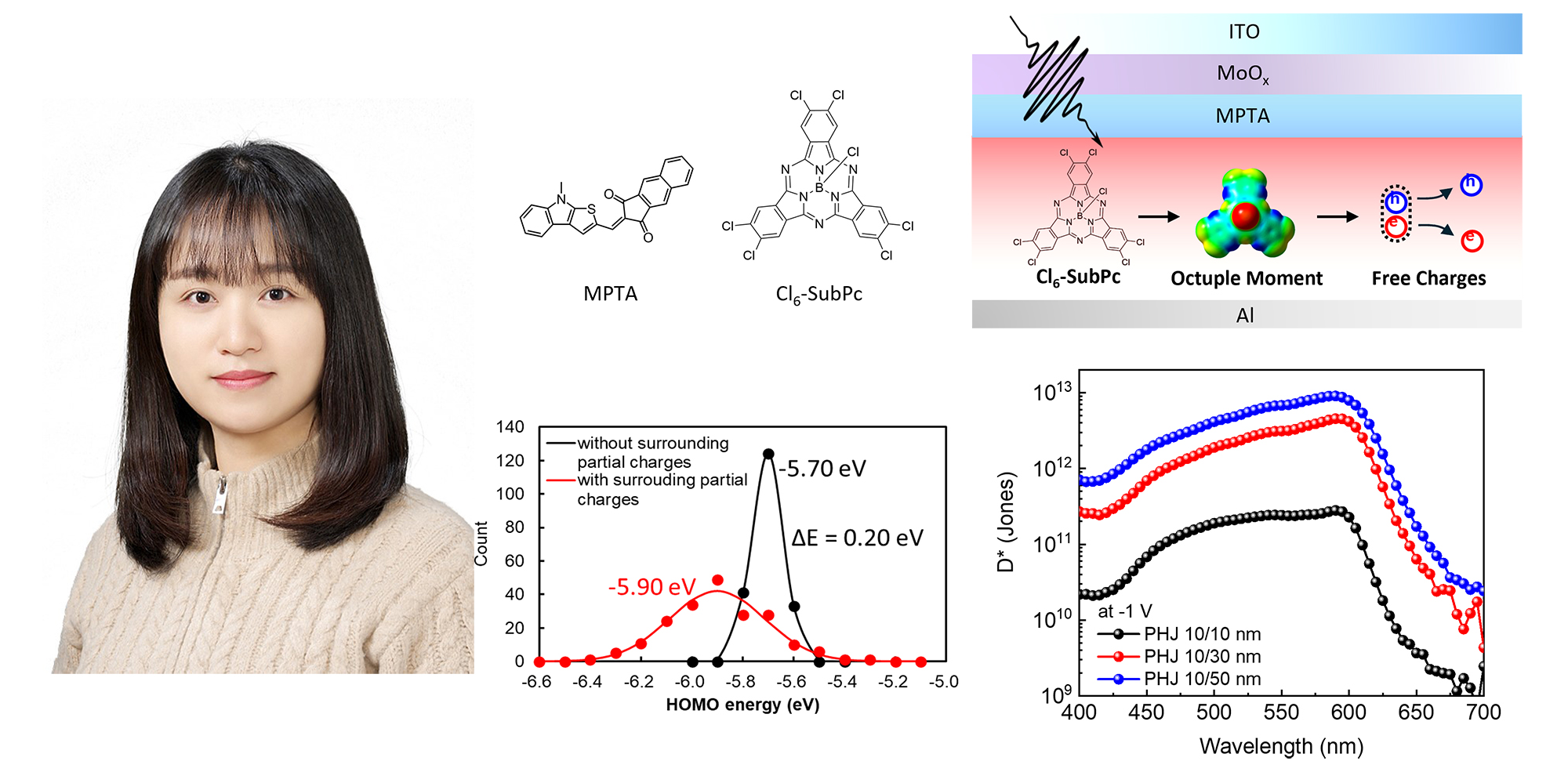커뮤니티
부경투데이
- 국립 부경대학교의 다양한 모습과 소식을 접하시면 부경대학교가 한번 더 가까워집니다.
| 네이처 자매지에 연구성과 발표(Research findings published in a Nature sister journal) | |||
| 작성자 | 대외협력과 | 작성일 | 2024-06-20 |
| 조회수 | 755 | ||
| 네이처 자매지에 연구성과 발표(Research findings published in a Nature sister journal) | |||||
 |
대외협력과 |  |
2024-06-20 |  |
755 |
유기 광센서 소자 성능 3배↑ 연구, 네이처 자매지에 발표
- 국립부경대 박송이 교수, 고성능 유기 광센서 소자 위한 유기 반도체 특성 규명

△ 박송이 교수와 연구 관련 이미지. 연구에 사용된 유기 반도체 분자 구조와 광센서 소자 구조 및 광전 변환 과정 모식도(위), Cl6-SubPc 박막 내 에너지 준위 분리 시뮬레이션 결과(아래 왼쪽), Cl6-SubPc 두께에 따른 광검출능 결과(아래 오른쪽).
차세대 이미지 센서로 떠오르는 유기 광센서 소자의 성능을 기존보다 3배 이상 높일 수 있다는 연구 결과가 나와 주목받고 있다.
국립부경대학교 박송이 교수(물리학과)는 유기 광센서 소자의 광검출능(Detectivity)을 높이고 공정 과정을 간소화할 수 있는 유기 반도체 소재 특성을 규명한 연구 결과를 최근 국제학술지 <네이처 커뮤니케이션스(Nature Communications)>에 발표했다.
광센서는 빛을 전기 신호로 변환해 주는 전자 소자다. 카메라 이미지 센서를 비롯 스마트 워치와 같은 웨어러블 전자 장치의 헬스 모니터링 센서에도 활용된다. 이 중 유기 광센서는 우수한 흡광능력과 밴드갭 조절의 용이함, 물리적 유연성 등의 특성을 갖는 유기 반도체를 광활성층으로 사용해 차세대 광센서 소자로 주목받으며 세계적으로 연구가 활발하다.
박송이 교수는 이번 연구에서 서브프탈로시아닌 화합물(Cl6-SubPc) 재료의 높은 팔중극자 모멘트가 빛 조사 시 자유 전하 생성에 핵심적인 역할을 한다는 연구 결과를 밝혔다.
일반적인 유기 반도체는 빛 조사 시 엑시톤이라고 불리는 전자-정공 쌍이 형성되는데, 이들의 결합 에너지가 커서 상온에서 자유 전자와 정공으로 쉽게 분리되지 못한다. 이러한 강한 결합 에너지를 극복하기 위해 2가지 이상의 재료를 무작위로 섞어 만드는 벌크-이종접합(Bulk-heterojunction) 또는 2가지 재료를 적층해 만드는 이중층(Planar-heterojunction, 이하 PHJ) 형태의 광활성층이 유기 광센서에서 주로 사용된다.
박송이 교수의 연구에 따르면 Cl6-SubPc 분자는 높은 팔중극자 모멘트로 인한 박막 내의 정전기적 전위차 유도 덕분에 자체적으로 에너지 준위 분리가 일어난다. 이러한 에너지 준위 차이를 통해 엑시톤이 손쉽게 자유 전자와 정공으로 분리가 된다.
그는 이번 연구에서 주 광활성층으로 Cl6-SubPc, 보조 광활성층과 정공전달층으로 MPTA를 사용해 PHJ 기반의 유기 광센서 소자를 제작하고 광·전기적 특성을 분석한 결과, 590 nm 파장의 빛에서 ~1013 Jones에 달하는 광검출능을 얻었다. 이는 기존에 보고된 PHJ 기반 유기 광센서 소자의 성능보다 3배 이상 향상된 결과다.
박 교수는 “Cl6-SubPc와 같이 높은 팔중극자 모멘트를 갖는 재료를 이용하면 단일재료와 단일층만으로도 우수한 성능의 광센서 소자 구현이 가능하고 공정 과정을 획기적으로 간소화할 수 있어 유기 광센서의 상용화를 앞당길 수 있을 것으로 기대한다.”라고 밝혔다.
이번 연구의 제1저자인 박송이 교수는 영국 임페리얼 칼리지 런던(Imperial College London), 삼성전자 종합기술원과 국제공동연구를 수행했다. 연구 결과를 담은 논문 ‘Octupole moment driven free charge generation in partially chlorinated subphthalocyanine for planar heterojunction organic photodetectors’는 <네이처 커뮤니케이션즈>에 6월 13일 게재됐다. <부경투데이>
Research on tripling the performance of organic photodetectors published in a Nature sister journal
- prof. Park Song-Yi from PKNU investigated characteristics of organic semiconductors for high-performance organic photodetectors
New research results have shown that the performance of organic photodetectors, which are emerging as next-generation image sensors, can be improved by more than three times compared to existing technologies, attracting significant attention.
Professor Park Song-Yi from the department of physics at Korea Pukyong National University recently published research findings in the international journal <Nature Communications>, identifying the characteristics of organic semiconductor materials that can enhance the detectivity of organic photodetector devices and simplify the fabrication process.
Photodetectors are electronic devices that convert light into electrical signals. They are used in various applications, including camera image sensors and health monitoring sensors in wearable electronic devices such as smartwatches. Among these, organic photodetectors are gaining global attention as next-generation photodetectors due to their excellent light absorption capability, ease of bandgap tuning, and physical flexibility, utilizing organic semiconductors as the photoactive layer.
In this study, Professor Park revealed that the high octupole moment of the subphthalocyanine compound (Cl6-SubPc) plays a crucial role in generating free charges upon light irradiation.
Generally, in organic semiconductors, light irradiation creates electron-hole pairs called excitons, which do not easily separate into free electrons and holes at room temperature due to their high binding energy. To overcome this strong binding energy, bulk-heterojunctions, which mix two or more materials randomly, or planar-heterojunctions (PHJs), which layer two materials, are commonly used as photoactive layers in organic photodetectors.
According to professor Park's research, Cl6-SubPc molecules inherently exhibit energy level separation due to the electrostatic potential difference induced by their high octupole moment in the thin film. This energy level difference allows excitons to readily separate into free electrons and holes.
In the study, PHJ-based organic photodetector devices were fabricated using Cl6-SubPc as the main photoactive layer and MPTA as the auxiliary photoactive and hole transport layer, and the analysis of their optical and electrical properties resulted in a detectivity of ~1013 Jones at a wavelength of 590 nm. This performance is more than three times higher than that of previously reported PHJ-based organic photodetector devices.
Professor Park said, "Using materials with high octupole moments like Cl6-SubPc can enable the realization of high-performance photodetectors with a single material and single layer, significantly simplifying the fabrication process and potentially accelerating the commercialization of organic photodetectors."
As the first author of this study, she conducted international collaborative research with Imperial college London in the UK and the Samsung advanced institute of technology. Her research findings are detailed in the paper titled 'Octupole moment driven free charge generation in partially chlorinated subphthalocyanine for planar heterojunction organic photodetectors', which was published in the June 13 issue of Nature communications. <Pukyong Today>